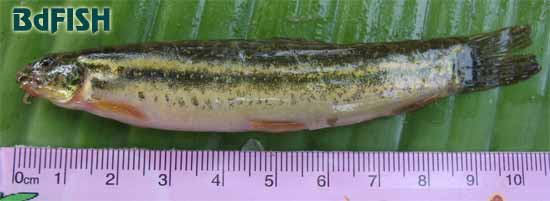
Systematic position:
Phylum: Chordata
Class: Actinopterygii (Ray-finned fishes)
Order: Cypriniformes (Carps)
Family: Cobitidae (Loaches)
Genus: Lepidocephalus
Species: L. guntea
Synonyms:
Canthophrys olivaceus Swainson, 1839; Canthophrys vittatus Swainson, 1839; Cobitis balgara Hamilton, 1822; Cobitis guntea Hamilton, 1822; Cobitis maya Sykes, 1839; Cobitis phoxocheila McClelland, 1839; Lepidocephalichthys balgara (Hamilton, 1822); Lepidocephalichthys guntea (Hamilton, 1822); Lepidocephalichthys guntea balgara (Hamilton, 1822); Lepidocephalichthys nepalensis Shrestha, 1980; Lepidocephalus dibruensis Sen, 1979; Lepidocephalus guntea balgara (Hamilton, 1822); Lepidocephalus nepalensis (Shrestha, 1980); Misgurnus lateralis Günther, 1868; Schistura aculeata McClelland, 1939 and Schistura balgara (Hamilton, 1822).
Common names: Gutum, Gutia, Gorkun, Poa, Puiya (Bangladesh); Guntea loach (Fishbase).
Distribution: Pakistan; Northern India; Nepal, Myanmar, Thailand and Bangladesh (Talwar and Jhingran, 1991).
Conservation status: Non threatened.
Morphology:
Body elongated and laterally compressed. Dorsal and ventral profile almost straight and parallel. Barbels 3 pairs including 2 pairs of rostral and a single pair of maxillary barbels. Caudal fin rounded and with no lateral line. Pectoral with an osseous spine in male (Rahman, 1989).
Body color is usually darkish yellow. A black colored spot (ocellus) on the upper half of caudal fin base. A light band runs from snout to the base of caudal fin and there are 2 dark blotches below and above this light band.
Head 18.6% SL and 15.4% TL. Height 18.6% SL and 15.4% TL. Eye 12.5% HL.
Fin formula: D. 8 (2/6); P1. 8-9; P2. 7-8; A. 7 (2/5)
Maximum length: Maximum length reported 15 cm (Talwar and Jhingran, 1991; Shafi and Quddus, 1982), 9.2 cm (Hussain, 1999), and 9.6 cm (Rahman, 1989 and 2005). Highest length measured 10.4 cm from Chalan beel (Bangladesh) in 2007.
Habitat: Found in freshwater bodies. Recorded from the Chalan Beel (Galib et al., 2009); Choto Jamuna river (Galib et al., 2013); Halti beel (Imteazzaman and Galib, 2013), streams of Mymensingh, Sylhet, Dinajpur and Rangpur (Rahman, 1989). Shafi and Quddus (1982) stated that this fish is found in abundance in canals, haor-baors, and rivers of Bangladesh and prefers muddy bottom. Found in flowing or clear standing waters (Talwar and Jhingran, 1991).
Breeding: Breeding time reported from July to September (Bangladesh).
Economics importance: As food and ornamental fish. Used as food fish in Bangladesh.
Harvesting and marketing: Marketed fresh or in dried (Samad et al., 2009) conditions. Harvested with different fishing traps especially Kholsun. Khepla jal (net), Hocha jal, Tana jal and veshal jal were also reported to harvest this fish (Shafi and Quddus, 1982).
_____________________________________________________________
References
Galib SM, Samad MA, Mohsin ABM, Flowra FA and Alam MT (2009) Present Status of Fishes in the Chalan Beel- the Largest Beel (Wetland) of Bangladesh. International Journal of Animal and Fisheries Science 2(3): 214-218.
Galib SM, Naser SMA, Mohsin ABM, Chaki N and Fahad MFH (2013) Fish diversity of the River Choto Jamuna, Bangladesh: Present status and conservation needs. International Journal of Biodiversity and Conservation 5(6): 389-395. DOI: 10.5897/IJBC2013.0552
Hamilton, F., 1822. An account of the fishes found in the river Ganges and its branches, Edinburgh & London, Fishes Ganges, 405 p.
Hussain, M.M., 1999. Fishes and Fisheries of the River Atrai in Rajshahi with Reference to its Limnology, unpublished Ph.D. thesis, Department of Zoology, University of Rajshahi, Bangladesh, pp. 5-200.
Imteazzaman AM and Galib SM (2013) Fish Fauna of Halti Beel, Bangladesh. International Journal of Current Research 5(1): 187-190. download this paper
Rahman, A.K.A., 1989. Freshwater Fishes of Bangladesh, 1st edition, Zoological Society of Bangladesh, Department of Zoology, University of Dhaka, Dhaka-1000, pp. 123.
Samad MA, Galib SM, Flowra FA (2009) Fish Drying in Chalan Beel Areas. Bangladesh Journal of Scientific and Industrial Research 44(4): 461-466. DOI: 10.3329/bjsir.v44i4.4599
Shafi, M. and Quddus, M.A.A. 1982. Bangladesher Matshya Sampad (in Bengeli), Bangla Academy, Dhaka, pp. 1-444.
Talwar, P.K. and A.G. Jhingran, 1991. Inland Fishes of India and Adjacent Countries, Vol. I, Oxford & IBH Publishing Co. Pvt. Ltd. New Delhi-Calcutta, pp. 172-173.
Visited 4,734 times, 1 visits today | Have any fisheries relevant question?
